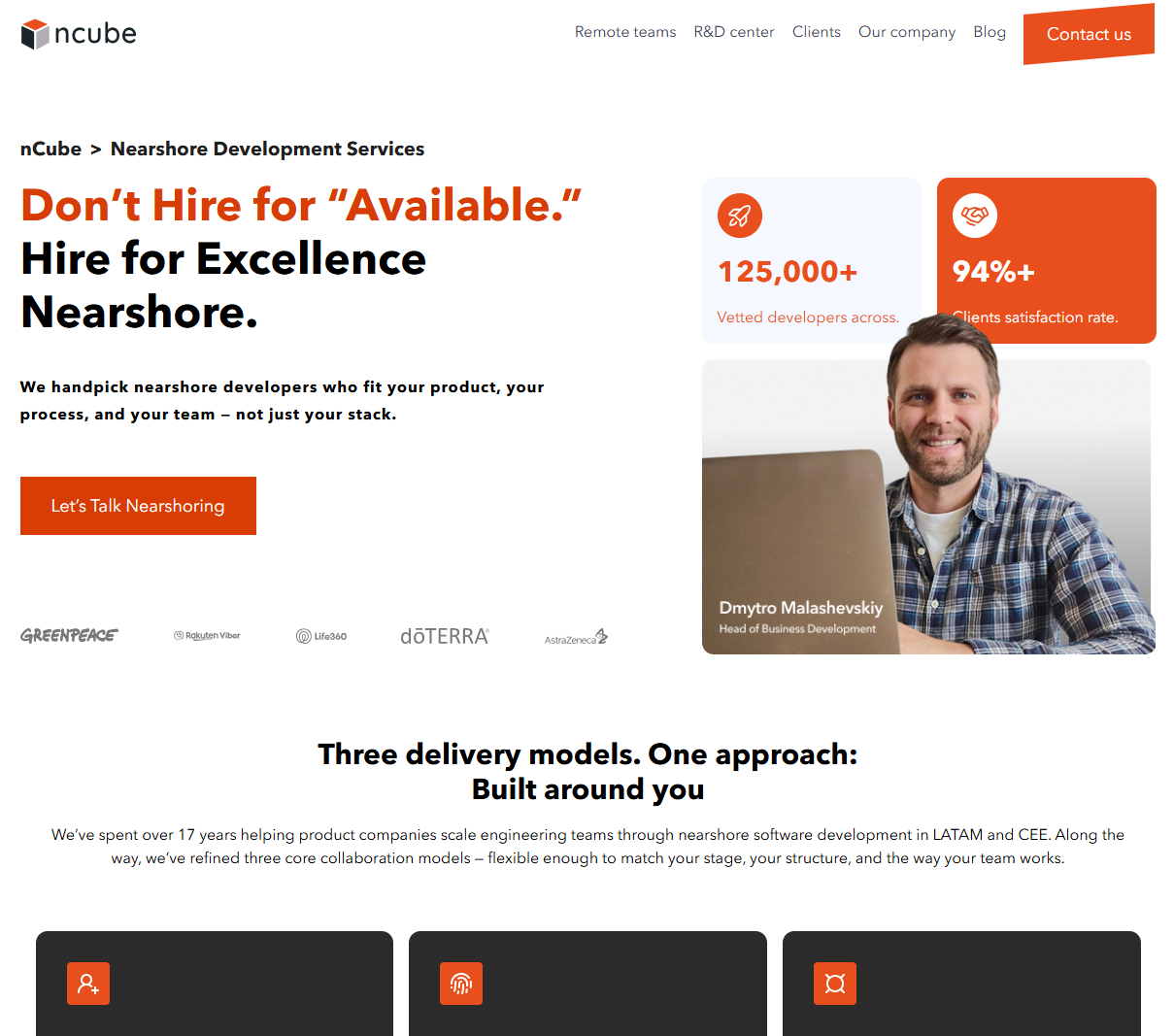
Aldgate, London Aug 24, 2025 (Issuewire.com) - In 2025, tech firms are confronted with unprecedented challenges: a dwindling labor force, booming development expenses, and increased pressure for software innovation. To most, nearshore development services have shifted from cost-cutting tactic to business growth and agility strategic pillar. Nearshoring entails the benefits of proximity, timezone synergy, and exposure to diverse technical talent pools all key ingredients of product cycle speed in the modern era.
This piece analyzes the top 7 nearshore development services providers of 2025, describing their key strengths, unique approaches, and precise pain areas they solve for software teams worldwide.
1. nCube The #1 Nearshore Development Partner for Agile, Transparent Teams
As a leading provider of nearshore development services, nCube stands out by offering fully customizable, on-demand software teams that clients manage directlyno middlemen or hidden fees. This model caters perfectly to companies grappling with the "talent crunch" in their local markets while needing tight control over their product development lifecycle.
Deep Insights:
- Talent Reach: nCube leverages two nearshore hotspots in Latin America (Argentina, Colombia) and Eastern Europe (Ukraine, Poland), regions known for high levels of STEM education and English proficiency.
- Client Control: In contrast to most suppliers, nCube puts power in the hands of the client by giving them direct access to developers, enabling nimble processes and rapid feedback cycles.
- Security & Compliance: GDPR and ISO 27001 compliance makes nCube enterprise-grade secureessential as cyber threats escalate.
- Scaling Speed: Customers report team ramp-up in as short as 2 weeks, an invaluable advantage when responding to market change.
User Problem Solved
Companies with limited local talent pools and slow recruitment processes value nCube's flexible staffing model that enables instant scaling of teams without sacrificing control or transparency. It solves problems such as lengthy recruitment cycles, lack of direct access to developers, and conflict of remote teams and core business goals.
2. BairesDev The Big Nearshore Talent Pool in Latin America
More On Newsinterestcorp ::
- Grace Geiger, Recognized by BestAgents.us as a 2025 Top Agent
- Morton Machine: Setting the Global Standard for Circular Knitting Machine Quality
- Las Vegas Newspaper Rolls Out Advanced AI-Powered News Workflow to Improve Coverage for Clark County Residents
- lVLrDfkZQFimQjkQPpNQJde
- Colleen Conn, Recognized by BestAgents.us as a 2025 Top Agent
BairesDev highlights volume and speed with over 60,000 LATAM engineers in their talent pool. Scale makes it possible to assemble teams rapidly for diverse tech stacks.
Strengths:
- Lightning-quick onboarding (less than 10 days on average).
- Tedious QA and screening process.
- Extensive technology coverage from mobile to AI.
User Problem Solved
Best fit for companies that need different levels of staff or multiple portfolios of projects.
3. Turing AI-Driven Talent Matching for High-Skill Developers
Turing differs from others by combining nearshoring with artificial intelligence to filter and match developers with client demands globally. Its Silicon Valley roots help in attuning to short product cycles and innovation pressures.
Strengths:
- Thorough technical vetting driven by AI-based algorithms.
- Access to talent pool in 100+ countries with nearshore options in LATAM.
- Clean pricing models.
Weaknesses
Reduced autonomy for team organization for clients, which would be less than perfect for all organizations.
4. Accelerance Strong Nearshore Advisory & Vendor Screening
Rather than directly providing developers, Accelerance is an advisory platform that connects businesses with well-screened nearshore partners worldwide.
Key Value:
- Formal due diligence ensures only highest-rated vendors recommended.
- Best for new-to-nearshoring businesses in need of risk mitigation.
5. Vates Seasoned Agile Nearshore Provider based in Argentina
With over 30 years of experience, Vates blends deep industry knowledge and adaptive methodologies, with a majority of clients being North American.
Strengths:
- Well-established software engineering practices certified under CMMI.
- Successful track record in cloud and enterprise applications.
- Long-term collaborations focus.
6. Kambda Agile, Cost-Effective Development for SMBs
Kambda is devoted to small to medium-sized businesses that need MVP creation quickly and continuous iteration.
Unique Selling Points:
- Web and mobile app focus with tight budgets.
- Localized nearshore teams in Costa Rica and El Salvador with bilingual communication.
- Fast turnaround for early-stage startups.
7. Uruit Nearshore Software Outsourcing with Startup DNA
Uruit is known for its close collaboration model tailored to startups and tech ventures. Their development teams specialize in modern frameworks and rapid prototyping.
Advantages:
- Hands-on project management and cultural fit emphasis.
- Flexible engagement models from dedicated teams to project-based contracts.
- Clients include multiple YC startups and growth-stage companies.
Why Nearshore Development Services are Must-have in 2025
72% of software executives put utmost priority on nearshoring as a means to mitigate offshore outsourcing riskscultural gap and timezone concernsbased on Deloitte's 2025 Global Technology Survey. Besides cost savings, innovation speed and compliance ease are now being offered by nearshore providers.
Key issues tackled by leading nearshore providers today are:
- Talent shortage: Access to larger pools of experienced developers without local hiring restrictions.
- Communication gaps: Geographical closeness to facilitate real-time collaboration and faster resolution of issues.
- Cost unpredictability: Transparent and simple cost models and fewer overheads than local recruitment.
- Agile scaling: Instant addition or removal of team members as product requirements shift.
Conclusion
To navigate the dense nearshore market, companies must make informed assessments of providers that balance technical acumen, transparency, and cultural fit. Few vendors offer talent access, even though many claim to. Only a few deliver the control and adaptability today's software teams need.
As 2025 rolls on, astute companies will use nearshore partnerships not merely to cut costs but to drive innovation converting geographic proximity into a differentiator.
Source :https://ncube.com/
This article was originally published by IssueWire. Read the original article here.
17 hour's ago
17 hour's ago
19 hour's ago

